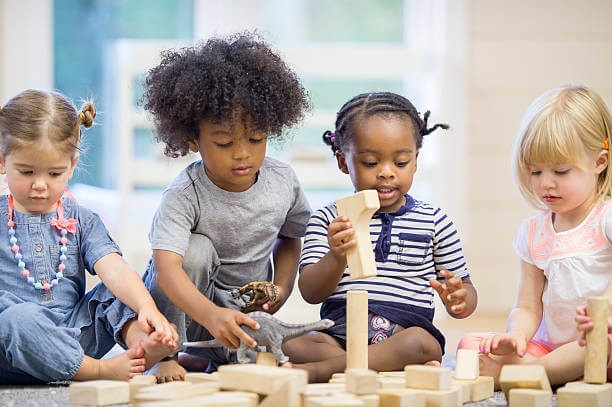Kinesthetic learning style, also known as tactile learning, is a powerful method where students learn best through physical activities, hands-on tasks, and movement. At LEARNS.EDU.VN, we understand that kinesthetic learners thrive by doing and experiencing. Discover how to harness this active approach to boost learning outcomes. Explore various activities and teaching methods that cater to tactile learning preferences, fostering deeper understanding and long-term retention.
1. Understanding Kinesthetic Learning: What Is It?
Kinesthetic learning, sometimes called tactile learning, is a style where learning happens best through physical activity. It’s about understanding through doing.
Think of it as the “hands-on” approach to education. Learners grasp concepts by touching, moving, and engaging in activities. Kinesthetic learners retain information better through movement and direct experience. They often excel in subjects that involve physical tasks and real-world applications.
According to Vanderbilt University, kinesthetic learning is one of the three primary learning styles. This contrasts with visual and auditory learning, where students learn by seeing or hearing. Kinesthetic learners need to move and interact to truly understand.
2. Kinesthetic Learning: Statistics and Trends in 2024
Kinesthetic learning is a game-changer for students who learn best by doing. It’s more than just a trend; it’s a proven way to boost understanding and retention.
- Prevalence: Roughly 15-20% of learners thrive with kinesthetic methods.
- Retention Rates: Active participation can increase information retention by up to 75%.
- Educational Impact: Project-based learning and maker spaces are on the rise, creating more kinesthetic opportunities.
- Tech Integration: AR and VR tools enhance learning by simulating real-world experiences.
These trends underscore the importance of movement and active involvement in modern education.
3. The VARK Model and Kinesthetic Learning
The VARK model, developed by Neil Fleming, identifies four main learning styles. It helps educators and learners understand preferred learning methods.
The VARK model includes:
- Visual: Learning through images, diagrams, and visual aids.
- Auditory: Learning through listening and verbal explanations.
- Reading/Writing: Learning through written words and text.
- Kinesthetic: Learning through physical activities and hands-on experiences.
Kinesthetic learners benefit from active involvement. They often struggle with passive learning methods. Understanding the VARK model helps tailor teaching to meet diverse needs.
4. How Kinesthetic Learners Grasp New Concepts
Kinesthetic learners thrive on real-life experiences and physical activities. They learn by doing, touching, and manipulating objects.
Active participation is key for kinesthetic learners. They enjoy acting out scenarios and applying knowledge to real-world situations.
Consider learning to ride a bike. No amount of instruction can replace getting on the bike and practicing. Kinesthetic learning is about direct experience.
| Feature | Kinesthetic Learners | Visual Learners |
|---|---|---|
| Memory Retention | Retain information better when actively doing something. | Retain information better when seeing visual representations. |
| Learning Environment | Prefer active environments with movement and engagement. | Prefer visually stimulating environments. |
| Effective Techniques | Benefit from role-playing, experiments, and physical activity techniques. | Benefit from flashcards, diagrams, and charts. |



5. Key Characteristics of a Kinesthetic Learning Style
Kinesthetic learners excel when they can physically connect with a concept. Movement and physical activity are crucial for effective learning.
They often mimic actions, touch objects, and fidget if forced to sit still. These behaviors indicate a need for kinesthetic engagement.
Common traits include:
- Good spatial awareness and physical coordination
- Preference for active activities like sports and dance
- Ability to multitask while performing physical tasks
Understanding these characteristics helps educators provide tailored support. Active learning opportunities can help kinesthetic learners reach their full potential.
6. Benefits of Embracing Kinesthetic Learning
Kinesthetic learning offers significant advantages, enhancing comprehension and cognitive development. By actively engaging with the material, students deepen their understanding and retention.
Let’s explore the key benefits:
6.1. Enhanced Comprehension
Traditional teaching methods may hinder kinesthetic learners. They need hands-on activities to fully engage with the material.
If teachers don’t recognize the importance of different learning styles, kinesthetic learners may struggle. This can lead to frustration and disengagement.
When teaching aligns with their learning style, comprehension improves. This leads to better academic performance and greater engagement.
6.2. Supports Cognitive Development
Studies show a strong link between movement and cognitive function. Pairing movement with cognitive tasks helps kinesthetic learners stay focused.
Movement also helps in understanding abstract concepts. Physical activity provides a concrete representation of ideas.
By engaging both body and mind, kinesthetic learners enhance retention, understanding, and creativity.
6.3. Improved Social Skills
Kinesthetic learning often involves group work and collaboration. This fosters teamwork and communication skills.
Group role-playing, teamwork, and cooperation are essential elements. They help kinesthetic learners develop vital social skills.
Working together on physical tasks enhances listening, feedback, and problem-solving abilities.
6.4. Boosts Creative Thinking
Kinesthetic learning encourages divergent thinking. It promotes the ability to generate multiple solutions to a problem.
Physical activities help learners approach problems from different angles. They explore multiple solutions and experiment with new ideas.
Activities like building projects enhance creativity and imagination. Kinesthetic learners discover new ways of thinking through physical engagement.
6.5. Enhances Muscle Memory
Kinesthetic learning improves muscle memory. It engages the body in the learning process.
Muscle memory is the ability to repeat a physical task without conscious thought. It develops through repeated practice.
Kinesthetic activities involve whole-body engagement. This develops muscle memory by engaging multiple muscle groups.
Examples include:
- Sports like basketball and dance routines
- Performing arts such as theater and dance
- Fine motor skills like drawing and playing instruments
7. Three Examples of Hands-On Learning Activities
Learning is most effective when hands, mind, and body work together. Participate actively in these activities through building, role-playing, and experimenting.
Engage in real-world connections and collaborate to deepen your understanding.
7.1. Building a Model to Explore Anatomy
- Scenario: Biology class learning about the human skeletal system.
- Preparation:
- Provide materials like clay, pipe cleaners, bone images, or skeleton model kits.
- Include labeled diagrams and explain how bones connect.
- Activity Steps:
- Discuss key parts of the skeletal system like the femur, humerus, and skull.
- Assign groups to build specific sections of the skeleton.
- Name each bone aloud and discuss its function.
- Assemble the full skeleton collaboratively.
- Move the joints to see how they articulate and discuss cartilage and ligaments.
- Follow-Up: Quiz each other by pointing to bones and naming their functions. Compare the model to X-rays or 3D simulations.
7.2. Historical Events Through Role-Playing
- Scenario: History lesson on the American Revolution.
- Preparation:
- Create scripts or summaries for key events like the Boston Tea Party.
- Assign roles such as George Washington, King George III, or Thomas Jefferson.
- Provide props like costumes, hats, scrolls, or flags.
- Activity Steps:
- Introduce the historical event with a short lecture or video.
- Assign roles and distribute scripts, allowing time for review.
- Set up the scene in the classroom, simulating the environment.
- Act out the scene, encouraging improvisation while staying true to historical facts.
- Pause at key moments to ask reflective questions.
- Follow-up: Discuss the roles, share learnings, and connect events to modern implications.
7.3. Conducting a Science Experiment to Discover Newton’s Laws of Motion
- Scenario: Physics class studying Newton’s laws of motion.
- Preparation:
- Gather materials: toy cars, ramps, measuring tapes, stopwatches, and weights.
- Prepare a worksheet to record observations.
- Activity Steps:
- Discuss Newton’s laws of motion, focusing on force, friction, and acceleration.
- Divide students into groups and provide materials.
- Set up a ramp at a specific angle and release the car from the top.
- Measure how far the car travels and how long it takes to reach the bottom.
- Repeat the experiment, changing variables such as the ramp’s angle.
- Analyze the data and compare results across different setups.
- Follow-up: Present findings to the class, highlighting how the data supports or refutes hypotheses. Discuss real-world applications.
8. Kinesthetic Teaching Tools: Engaging the Senses
Several tools and activities can help kinesthetic learners understand and retain information. By incorporating these, educators can create a more engaging learning environment.
Let’s look at some kinesthetic learning activities:
8.1. Animations: Bringing Concepts to Life
Animations use sequential images to represent movement and change. They can explain complex concepts and demonstrate processes.
Animations tell stories and simplify intricate ideas. They engage kinesthetic learners through visual and dynamic representations.
For example, you can create animations to explain evaporation or the circulatory system. This makes learning interactive and easier to grasp.
8.2. Stand-on Simulations: Active Role-Playing
Stand-on simulations involve participants standing throughout the exercise. This helps improve physical stamina, coordination, and decision-making skills.
Participants role-play different scenarios while standing in a simulated environment. This provides a dynamic and engaging learning experience.
Kinesthetic learners use their bodies to internalize new information. They develop problem-solving skills by reacting quickly in motion.
8.3. Micro-Learning Lessons: Short and Sweet
Microlearning delivers content in short, focused lessons. These bite-sized lessons are easy to consume quickly.
Microlearning lessons focus on one objective at a time. They range from a few minutes to 15 minutes.
Lessons can include experiments, videos, podcasts, infographics, and interactive quizzes. This makes learning more interactive and engaging.
By breaking down content, learners absorb information more easily and retain it longer.
8.4. Interactive Documents: Engaging Content
Interactive documents allow users to engage with content in a more dynamic way. Unlike static documents, they include multimedia elements.
Interactive documents have images, videos, GIFs, and clickable links. They make navigation and exploration easier.
Examples include:
- Interactive PDFs
- E-books
- Online magazines
- Interactive digital presentations
Interactive documents present information and assess learning outcomes in an engaging way.
8.5. Role-Playing Exercises: Real-World Simulation
Role-playing simulates real-life situations. Learners take on different roles or characters.
Role-playing is effective for kinesthetic learners. It provides hands-on engagement with the material.
For instance, in a conflict resolution lesson, students can act out a disagreement between friends. They practice effective communication, active listening, and problem-solving.
After the role-play, discussions highlight what worked well and how to improve. Real-life examples help learners understand better.
9. Kinesthetic Teaching Methods: Strategies for the Classroom
As an educator, identifying kinesthetic learners allows you to tailor teaching methods. Incorporating kinesthetic learning benefits all students.
Let’s explore ways to provide a kinesthetic learning experience.
9.1. Integrating Kinesthetic-Friendly Activities into Lessons
Research indicates that the average adult attention span is 10 to 20 minutes. Shorter lessons help learners stay engaged.
Introduce activities to develop various skills and abilities. Shorter lessons allow learners to focus on a smaller amount of material.
This is particularly important for kinesthetic learners who struggle with longer lessons. Shorter lessons also provide more opportunities for review.
By incorporating kinesthetic-friendly activities, you can fully engage kinesthetic learners.
9.2. Implementing Movement: Energize Learning
For kinesthetic learners, movement is essential. Allow them to move in the classroom.
Movement improves focus and attention. It provides an outlet for excess energy and encourages creativity.
Establish clear guidelines for movement. Set expectations for activities, rules for movement, and noise levels.
Provide alternative activities for students who struggle with movement-based learning.
9.3. Motivating Students to Create Personal Notes
Encouraging students to take notes improves understanding and retention. It also enhances organizational skills.
Note-taking reinforces learning. It allows students to review material and identify areas needing clarification.
Encourage various note-taking styles until students find what works best.
9.4. Taking the Class Outside: Connect with Nature
Taking the class outside provides opportunities for hands-on engagement with the environment. Students can explore through sight, sound, touch, and smell.
Kinesthetic learners benefit from real-world connections. Taking the class outside makes learning tangible.
10. Steps to Introduce Kinesthetic Learning Style
If you’re interested in incorporating kinesthetic activities, certain steps can help.
10.1. Experiencing Kinesthetic Learning Firsthand
Try kinesthetic learning yourself. Learn things through physical involvement.
Start at home. Try something new like decorating, baking, or planting.
By doing it physically, you can develop effective implementation methods.
10.2. Practicing Demonstrations in Class
Show is often more important than tell. Create a hands-on experience to understand each topic.
Develop skills in physically demonstrating concepts.
10.3. Walking or Standing While Teaching
Standing up and moving around helps maintain student attention and engagement. It also makes you more visible.
If you typically sit, practice standing at home before implementing it in class.
10.4. Accepting Mistakes and Continuously Improving
Mistakes are inevitable when trying something new. Don’t give up if there are setbacks.
Be open-minded and discuss progress with students. Learn what works and adjust accordingly.
11. Career Paths for Kinesthetic Learners
Motivating students with kinesthetic learning prepares them for various careers.
Consider these options:
- Physician: Medical training involves hands-on experience.
- Automotive Mechanic: Requires hands-on work with tools and problem-solving skills.
- Sports Coach: Effective coaches demonstrate techniques and communicate through physical movement.
12. Start Teaching with the Kinesthetic Learning Style
Kinesthetic learning boosts information retention, engagement, and physical activity.
Teachers should learn student preferences to create tailored lesson plans. By embracing kinesthetic learning, educators cater to individual needs, fostering a richer, more effective learning experience. Explore the resources at LEARNS.EDU.VN for more insights and support.
For additional resources and to further enhance your understanding and teaching methods, visit LEARNS.EDU.VN, or contact us at 123 Education Way, Learnville, CA 90210, United States. You can also reach us via WhatsApp at +1 555-555-1212. Let LEARNS.EDU.VN be your partner in creating engaging and effective learning experiences.
Frequently Asked Questions (FAQs) About Kinesthetic Learning
Here are some common questions about kinesthetic learning to help you understand it better:
- What is kinesthetic learning?
Kinesthetic learning is a style where individuals learn best through physical activities and hands-on experiences. It involves touching, moving, and doing to understand and retain information. - How can I identify if my child or student is a kinesthetic learner?
Look for signs like fidgeting, enjoying physical activities, and learning by doing rather than reading or listening. - What are some effective teaching strategies for kinesthetic learners?
Effective strategies include hands-on activities, experiments, role-playing, and incorporating movement into lessons. - Can kinesthetic learners succeed in traditional classroom settings?
Yes, with the right support and teaching strategies that incorporate physical engagement. - What tools can help kinesthetic learners?
Tools like interactive models, building kits, and educational games can make learning more engaging. - How does kinesthetic learning differ from other learning styles?
Kinesthetic learning focuses on physical engagement, unlike visual and auditory learning, which rely on seeing and hearing. - What are the benefits of kinesthetic learning?
Benefits include improved comprehension, enhanced memory retention, and better engagement with the learning material. - Can kinesthetic learning be combined with other learning styles?
Yes, a multi-sensory approach that combines different learning styles can be highly effective. - How can I incorporate kinesthetic activities at home?
Incorporate activities like building models, conducting simple science experiments, and using movement-based learning games. - Where can I find more resources for kinesthetic learning?
Visit learns.edu.vn for detailed articles, courses, and tools designed to support kinesthetic learners and educators.
